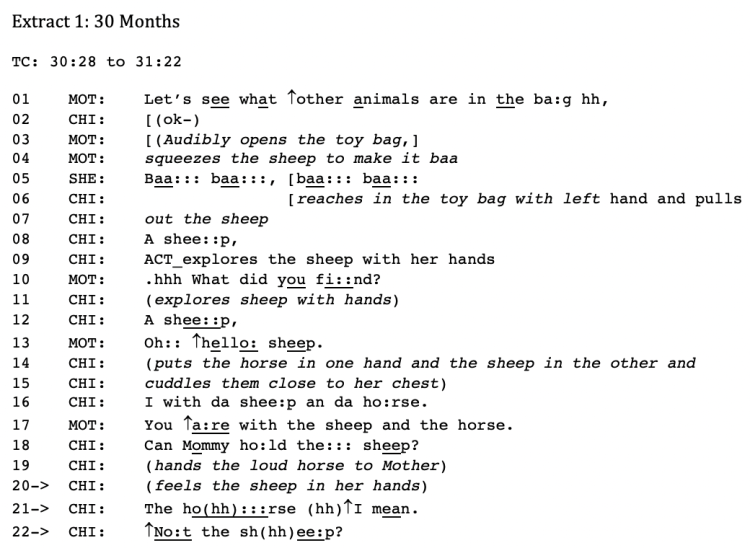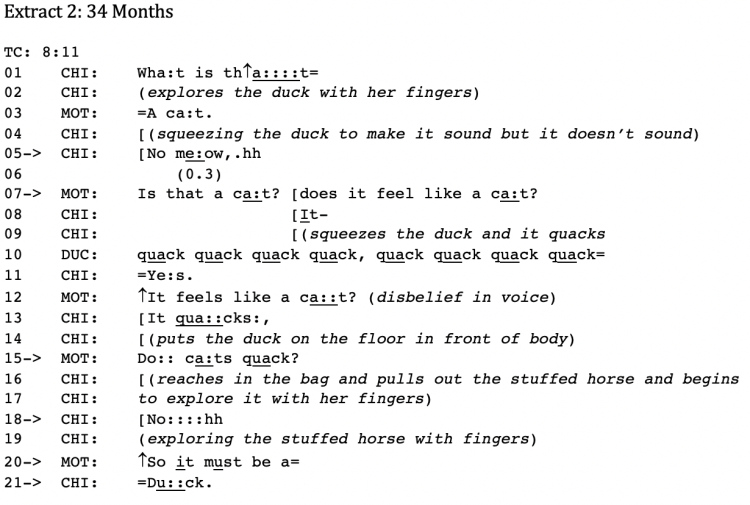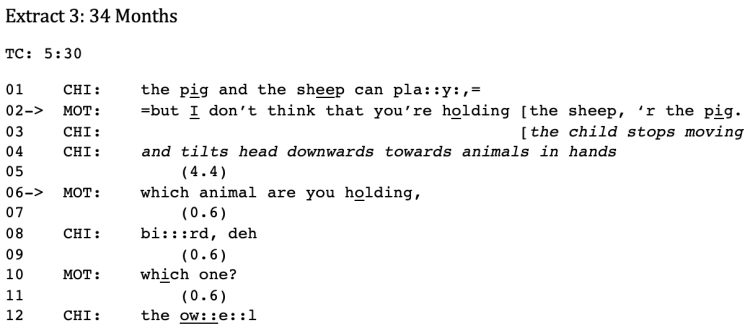Mother-Child Interaction: How Visual Access Affects Repair in Conversation
How do blind children learn to use language conversationally as it is used by sighted adults around them?
By Mara Strother
Course: Interactional Linguistics (LING 5800)
Advisor: Prof. Barbara Fox
LURA 2019
As children develop conversational skills, they orient to adults as sources of confirmation and correction of both verbal speech and understanding. Conversation itself is fundamentally multimodal, fluid, and error-filled, and thus must provide mechanisms for digressing from the continuity of the talk in an orderly manner, such that problems and troubles may be addressed, and progressivity may continue. Adults monitor their child’s language in order to locate sources of trouble and guide the child toward fixing them.
My case study of mother-child repair drew upon rare data of playtime interactions between a blind child and her sighted mother in order to provide preliminary analyses of how physically embodied or non-verbal resources (i.e. eye gaze, gesture, etc.) might be mobilized by the participants in order to achieve repair.
I desired to better understand if and how the child’s lack of visual access influences her understanding of and orientation to different types of repair—both self-initiated by the child and other-initiated by the mother. This case study did not intend to make far-reaching statements about how blind children differ from sighted children.
Using video data provided by Dr. Carolyn Rickard, I transcribed several interactions between a mother and her congenitally blind daughter. The activities in the videos are primarily routines in which the mother guides the child through a scaffolded stuffed animal toy identification and labelling task. Three conversational transcripts with data analysis follow.
In the first extract, the mother carefully positions the sheep in the toy bag and squeezes it to produce an audible noise in order to elicit the child’s attention and aid the child in locating the sheep inside the bag. After a manual exploration of the sheep (while simultaneously holding a horse in her other hand), the child decides to give the horse to the mother and mistakenly says “Can Mommy hold the sheep?” in line 18, which precedes a second manual search of the sheep in the child’s hands. The child physically scans the sheep, allowing her to gather the necessary information to initiate a self-repair on her earlier mistake. The child repairs only the incorrect labelling, not the entire question—which demonstrates evidence of her understanding of the syntax of repair in that she returns only to the beginning of the troublesome noun phrase in her repair.

In the second extract, the mother intentionally tricks the child by mislabeling a duck as a cat; the child begins a manual search of the duck, hoping to find features of a cat—hence the confusion in line 5 as the alleged “cat” does not produce a meowing sound when squeezed. As the blind child lacks access to the full gestalt of a stuffed animal on a visual level, she relies on both language input and interactional work organized by the mother, as well as tactile and auditory features of the stuffed animal in order to distinguish objects based on their smaller parts. The mother creates an organized, step-by-step sequence of questions to give the child more opportunities to produce the repair. In line 21, the child gives the correct label that fills the slot created by the mother in line 20.

In the third extract, the child mistakenly labels an owl as a pig (while holding an owl and sheep in her hands). When the mother says, “but I don’t think that you’re holding the sheep, ‘r the pig,” the child’s attention immediately shifts to the objects in her hands. The mother employs a question form to elicit a repair in line 6 when she says, “Which animal are you holding?” When the child does not give a specific answer, the mother asks, “Which one?” and the child accurately labels the bird in her hand as an owl. In this extract, the mother shifts to specific questions designed to repair some aspect of the child’s general label provision in line 8—likely to motivate further detail on the part of the child in labelling the stuffed animal as a specific member of the broader category of birds. This extract shows the intentional scaffolding created by the mother to aid the child in understanding multiple levels of categories with greater granularity. The process here would be less necessary (in terms of the child’s grasp of the difference between items) with an object like a pig, as an owl is a member of broader general category of birds and thus does not exist at the same categorical level as other stuffed animals like the pig.

In my preliminary analysis, I concluded that the mother initiates and scaffolds the repair when the child does not immediately notice a mistake in her verbal labelling and understanding of the objects, or when the mother purposefully wants to pause progressivity to ensure that the child learns something about categorizing objects by using her senses of touch and sound.
The mother promotes repair via: attention elicitation devices (i.e. squeezing an animal to produce a sound) with physical positioning and placement of an object for the child’s access, the use of questions to sequence repair on the part of the child, or to help the child hone her understanding of category labels and distinctions. Repair is a process essential to interaction, and thus must be learned early—and also be adapted to the speakers and context. In this case study, the mother intentionally creates structured conversation around a labelling activity to help the child develop her own techniques to fix troubles in her speech and understanding by educating the child on methods to help differentiate objects (i.e. touch and sound) and directing the child to carefully attend to varying levels of detail when defining categories.
I hope that further research ignites interest in the conversational resources used by blind children and their parents, as well as other understudied populations that have varying visual, auditory, or other access.
Opening Photo Credit
Agent Illustrateur/Ikon Images
https://www.npr.org/sections/health-shots/2014/12/19/371679655/some-early-childhood-experiences-shape-adult-life-but-which


